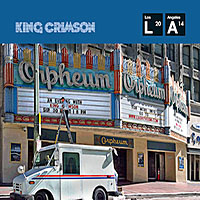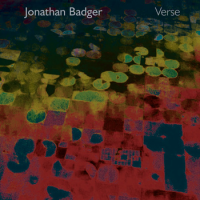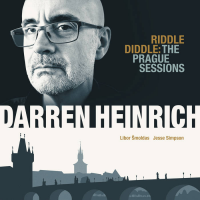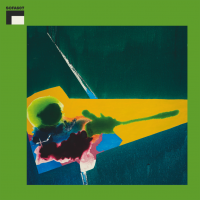Home » Jazz Articles » Extended Analysis » King Crimson: Live at the Orpheum
King Crimson: Live at the Orpheum
In retrospect it shouldn't have been that much of a surprise. In 2011, A Scarcity of Miracles (Panegyric) was released as "A King Crimson ProjeKct," the ProjeKcts being previously associated with experimental permutations and combinations of members from the 1994-1997 double trio Crimson that, in addition to Fripp, Belew, Gunn and Mastelotto, also included Levin and drummer Bill Bruford from the '80s-era incarnation responsible for albums including Discipline (E.G., 1981).
Scarcity was, however, an entirely different beast. It began as a duo project of improvisations between Fripp and guitarist/vocalist Jakko M. Jakszyk—who, despite being around for many years, had only begun to make a bigger name for himself since the turn of the millennium as a member of the Crimson alum-manned 21st Century Schizoid Band and his own superb Bruised Romantic Glee Club (Iceni, 2006). When the pair listened to the music they'd recorded, however, they decided to recruit saxophonist/flautist Mel Collins, last heard as a member of Crimson on Islands (Island, 1971) and associated touring that resulted in the group fracturing, but not before leaving a low-fi and largely dismissed live album, Earthbound (Island, 1972)—though he did make a guest appearance on Red (Island, 1975), the group's influential 1970s studio swan song. From there, one thing led to another and, with Jakszyk taking the recordings home to write lyrics and reshape the material into something more closely resembling song form, the trio became a quintet with the addition of Levin and Harrison.
Sadly—and unfairly—the album received mixed reviews, despite being one of the most flat-out beautiful song-form recordings Fripp has ever made with anyone, largely because it seemed that, with the Crimson ProjeKct moniker, critics felt somehow duty-bound to draw comparisons with virtually every Crimson album that came before. Jakszyk—in addition to being a remarkable guitarist as capable of pulling off lightning fast legato lines à la Allan Holdsworth as he is solos of profound lyricism and perfect simplicity—is an emotive but non- melismatic singer with a clearly distinct and recognizable voice, but far too many critics seemed unable to assess him on his own merits, with some comparing him to original Crimson vocalist Greg Lake, others to mid-'70s Crimson's John Wetton...and still others to both Lake and Wetton. They were all wrong.
And so, while Scarcity of Miracles deserved to be assessed on its own merits, for the most part it was not. But when Fripp announced Crimson's reformation two years later, it was no coincidence that the lineup included everyone from that album...plus two more drummers: Pat Mastelotto and Bill Rieflin, also a multi-instrumentalist who'd recorded two solo albums on which Fripp and Trey Gunn had participated (1999's Birth of a Giant and 2000's The Repercussions of Angelic Behavior, both on First World Records). While the emphasis was to largely be about revisiting music of Crimsons past (along with a couple of tunes from Scarcity and some very short new instrumental compositions), with Fripp flipping the traditional rock band lineup by making the drummers the front line—as if three drummers wasn't enough—and the rest of the musicians the back line, there was considerable controversy—doubt, even.
There needn't have been. The September, 2014 North American tour that took the Fripp-monikered "Seven-Headed Beast of Crim" on a nine-city, twenty-date run was not only met with almost entirely enthusiastic critical and popular acclaim, it proved that, as ever, Fripp's instincts were to be trusted as the three drummers were every bit the stars of the show as the rest of their bandmates, somehow managing to orchestrate amongst themselves in a way that was fluid, uncluttered and, perhaps most surprising, capable of making internal arrangement alterations from one night to the next...sometimes planned, other times completely—and remarkably—in the moment.
While the drummers acted as a fluid, single-bodied, twelve-limbed organism, much of the credit for realizing Fripp's conception of a three-drummer front line goes to Harrison, who was responsible for much of the arranging. But it was Mastelotto, Rieflin and Harrison who collectively brought it to life, as they managed to take a potential train wreck of three drummers and turn it into a truly marvellous, innovative thing of thundering power, finely honed grace and, at times, sheer beauty.
Based on the group's two-night run at San Francisco's legendary The Warfield, the groundswell of support was not just well-deserved; this was, it turns out, one of the best Crimson lineups ever...perhaps, even, the best, with the possible exception of the '72-'74 lineup recently documented in the third of three consecutive box sets to be released in as many years, Starless (Panegyric, 2014). This was a Crimson that may have been taking a good look back at its long legacy but this was no retro band; King Crimson 2014 was truly, well, as 21st century as they come.
There's even an argument to be made that despite the mid-'70s Crim's reputation as fearless and often ear-splitting improvisers, King Crimson 2014 is an even better unit because, with the addition of Collins' reed and woodwinds and three drummers who also bring electronics and, in the case of Rieflin, keyboards to the mix, this is a group that can play virtually anything from the group's 45-year repertoire, and do it in ways that previous, smaller incarnations could not—all with perfect intuition and dynamics. Jakszyk is a singer and guitarist who, while as riveting and talented as Belew, is a more integrated band member than his immediate predecessor, whose presence somehow seemed to dominate every incarnation he was in over the course of nearly three decades. Not that Belew's dominance was necessarily a bad thing, but it was, in some ways, self-limiting. And with Levin back, the group has a groove-heavy bassist capable of everything from Chapman stick and fretted and fretless basses to upright bass. Like Levin, it would seem that King Crimson 2014 has the chops to do just about anything.
A truth made all the more clear on Live at the Orpheum, the new line-up's first official release, recorded during its two- night Los Angeles run prior to moving north to San Francisco. It's a great reminder to those who saw the tour just how special this incarnation was, while allowing those unable to catch the shows to get some idea of what all the hubbub was about.
There will inevitably be those who will criticize co-producers Jakszyk and Fripp's decision not to include an entire performance but, instead, make it a vinyl-length recording—the double-disc CD version also includes the stereo mix in 24/96 Hi-Res on a DVD-A- -that only includes about a third of the group's live set. But there are two approaches to compiling a live release. One, the relatively easy route, is to present a full show (or a composite taken from multiple nights) that may represent the overall best performances while still containing all the inevitable minor imperfections that are part and parcel of any live performance—barely noticed, if at all, at the time but, with a permanent document, there to be heard time and again. The other, a more time and work-intensive approach, involves listening to each show's multitrack tapes in minute detail to identify the absolute best performances and then make any necessary minor (but not necessarily quick or easy) adjustments to remove those imperfections, creating a document capable of standing up to detailed scrutiny and of more lasting quality. A show, after all, is a fleeting thing, while a recording is intrinsically permanent.
Clearly Crimson opted for quality over quantity, but that meant, with just three months between the tour's end and the release of Live at the Orpheum, the work required to sift through hundreds of hours of high resolution multi-tracks may simply have been too great to manage anything more than its 41 minutes.
Based on the end result, however, Live at the Orpheum more precisely documents how King Crimson 2014 sounded; rather than a "warts and all" live recording put together on the quick, it suits—and, perhaps most importantly, respects—the detail, complexity and unbridled energy of the group's shows.
This was the first tour in decades where Fripp was clearly enjoying himself—and the first in years where he was actually lit up onstage with the rest of his musical co-conspirators. And so, unlike the 2008 tour, King Crimson 2014 is already planning to continue into 2015/16, meaning that more music will, no doubt, be coming—hopefully both in the form of live performances and recordings.
With a group that has, through numerous incarnations, consistently delivered music that's progressive in the real sense of the word, it would seem that Fripp and the musicians he's chosen for this eighth incarnation of the group deserve more than a little trust when it comes to releasing the best possible document; perhaps, later down the road, there will be time to memorialize an entire show. In the meantime, Live at the Orpheum doesn't just sound terrific, its sequence of seven tunes from across the decades stands perfectly well as its own self-contained entity.
With that in mind, Live at the Orpheum should not be criticized for what it lacks, but celebrated for what it possesses: a cross-section of material, some that has not been performed in decades and some that has not been performed live ever, along with a touch of new music that acts as introductions to other more familiar pieces. It may be only 41 minutes long but its setlist covers a full four decades, with material culled from Islands, Red and The ConstruKction of Light (Virgin, 2000).
Opening with a strange collage of pre-recorded walk on music, some brief group improvisation and a sample from the hidden track at the end of Islands where Fripp is instructing his string ensemble before counting in at a tempo that is absolutely not that of the first song, the band leaps into Red's "One More Red Nightmare," a song that Crimson has never before performed live—recorded, as it was, for an album created and released after the 1972-74 band had ceased touring and was in the process of dissolving. What's immediately noticeable is how big the sound is, without having to be unbearably loud (the tour was undeniably high volume, but not as ear- shattering as in the '70s). Having two guitars—allowing for Fripp's shimmering arpeggios and Jakszyk's grittily distorted wah wah riffs during two solo sections, as Collins positively soars, with a pitch shifter fattening his sound even more—makes a huge difference and, with the introduction to each verse containing brief solos passed around the three drummers like a relay baton, the power, versatility, excitement and potential of this seven-piece lineup is rendered immediately clear.
A brief Gamelan-inspired drum piece, "Banshee Legs Bell Hassle," leads into The ConstruKction of Light's title track, a knotty, irregularly metered instrumental where Jakszyk and Fripp's interlocking guitar parts mirror the drummers' previous reference points, with Levin's stick work providing a most complex kind of glue, whether the drums are in for support or not. The addition of Collins' flute, soloing over this complex polyrhythmic stew, seems made for the piece; his work throughout the album is, in fact, some of his most impressive in years...maybe even decades, as he's spent so much of his post-Crimson life as a session player and touring member with bands ranging from Dire Straits, Bad Company and Bryan Ferry to Tears for Fears, Clannad and Roger Waters. None of these associations, good as they are, ever pushed him to play the way he does in Crimson, and it's an absolute pleasure to hear him back with the group and clearly, at the age of 67, at the top of his game.
As is everyone. Jakszyk's delivery of Islands' "The Letters" ranges from haunting to visceral, and while Islands- era band live performances of the song are good, the ability to have two guitarists—allowing Fripp to layer his arpeggiations over Jakszyk's simpler chords—makes this the definitive recorded live version. Collins' mid-song baritone solo—always adhering to form in some oblique way, but evolving into screeching near-free jazz that no other Crimson has ever managed as well, thanks to the acute listening and push-pull of his bandmates—is another high point, as is his unfettered tenor work in the middle of "Sailor's Tale," also from Islands and long a fan favorite for Fripp's quirky, banjo-esque strummed solo and his signature sustaining tone that is featured during the initial 6/8 portion of the lengthy instrumental.
A closing look at Red's "Starless" again points out just how much more can be done with a larger ensemble, with Fripp sharing the solo spotlight with Collins. The first half of the tune, with Jakszyk's note-perfect and evocative voice, leads to a second section, where Levin's deep bass riff drives what's more a guitar anti-solo, based on ascending, repetitive single notes. What's not clear on the recording, however, is that it's Jakszyk who plays the first part of the solo, seamlessly handing it over to Fripp mid-stream. And with two guitars, saxophone, bass, two drummers and Rieflin on mellotron, the album (and, oftentimes, set) closer builds to a fiery climax and dramatic conclusion that even the high decibel '70s group could not achieve.
With a crystal clear drum mix—and the understanding that it's Mastelotto on the left, Harrison on the right and Rieflin in the center— it's possible to hear the remarkable interaction between the three players, though it's not quite the same as actually seeing it. Hopefully, at some point, on a future tour, there will be a video recording as this lineup has so much going on that being able to see it is, at times, every bit as important as hearing it. But it's a relatively small quibble, as the mix makes it possible, at least, to imagine it.
It may lack some of the other stunning music performed on tour by this group, including the first full-arrangement version of "Larks' Tongues in Aspic, Part I" since the early days of the '72-'74 group; versions of A Scarcity of Miracles' title track and more open-ended "The Light of Day" that trump the studio originals; high octane versions of "VROOM" from the double trio and "Level Five" from the 2000-'03 double duo; a version of "Pictures of a City," from In the Wake of Poseidon (Island, 1970) that again benefits from the larger lineup; and the encore of "21st Century Schizoid Man," from the group's 1969 debut, In the Court of the Crimson King (Island), that unexpectedly turns into a lengthy feature for Harrison after the briefest of solos from Fripp. But if nothing else—and there is, indeed, much more—Live at the Orpheum whets the appetite for what is, most certainly, a group with plenty still on the horizon.
Track Listing
Walk On: Monk Morph Chamber Music; One More Red Nightmare; Banshee Legs Bell Hassle; The ConstruKction of Light; The Letters; Sailor's Tale; Starless.
Personnel
King Crimson
band / ensemble / orchestraRobert Fripp: guitar, keyboards; Jakko M. Jakszyk: guitar, vocals; Mel Collins: saxophones, flutes; Tony Levin: basses, Chapman Stick; Pat Mastelotto: drums, electronics, percussion; Bill Rieflin: drums, keyboards, percussion; Gavin Harrison: drums, percussion.
Album information
Title: Live at the Orpheum | Year Released: 2015 | Record Label: Panegyric Recordings
Tags
About King Crimson
Instrument: Band / ensemble / orchestra
PREVIOUS / NEXT
Support All About Jazz
 All About Jazz has been a pillar of jazz since 1995, championing it as an art form and, more importantly, supporting the musicians who make it. Our enduring commitment has made "AAJ" one of the most culturally important websites of its kind, read by hundreds of thousands of fans, musicians and industry figures every month.
All About Jazz has been a pillar of jazz since 1995, championing it as an art form and, more importantly, supporting the musicians who make it. Our enduring commitment has made "AAJ" one of the most culturally important websites of its kind, read by hundreds of thousands of fans, musicians and industry figures every month.




















